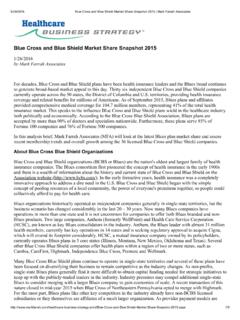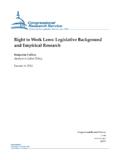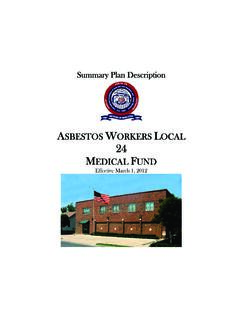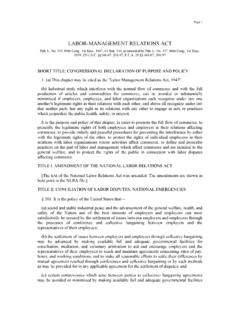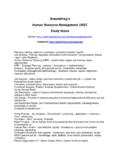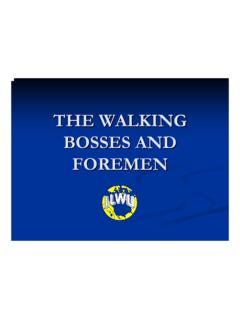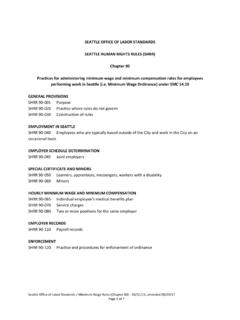Transcription of Health Coverage for Labor Union Markets - …
1 5/29/2018 Health Coverage for Labor Union Markets | Mark Farrah Coverage for Labor Union Markets2/11/2010 by Debra A. Donahue Organized Labor , representing one in ten Americans, is one of the most influential purchasing groups in thehealth care industry. Labor organizations in America have fought for and typically won better Health benefits formore than 30 million people on behalf of the million unionized workers. In the current economicenvironment, unions and employers are struggling to balance Health benefit changes against employment unions and Taft-Hartley plans consider Health benefit compromises, opportunities abound for Health plansthat have innovative cost control strategies. This brief examines Labor unions, Taft Hartley plans and the insurersthat have successfully partnered with in AmericaA trade or Labor Union is an organization of workers who have banded together to achieve common goals in keyareas, such as Health benefits.
2 The trade Union , through its leadership, bargains with the employer on behalf ofunion members and negotiates Labor contracts (collective bargaining) with January 2010, the Bureau of Labor Statistics (BLS) released membership data on unions in the United 2009, the number of workers belonging to unions declined by 771,000 to million, largely reflecting theoverall drop in employment due to the recession. According to the BLS report, the Union membership rate (thepercent of wage and salary workers who were members of a Union ) was , essentially unchanged a year ago. It is interesting to note that Union membership has fallen from million Union workers in1983, the first year where comparable Union data was number of public sector employees in unions, million, exceeds the million private sector the public sector, local government workers had the highest Union membership rate, This groupincludes workers in heavily unionized occupations, such as teachers, police officers, and fire fighters.
3 Privatesector industries with high unionization rates included transportation and utilities ( ), telecommunications( ), and construction ( ). From a Health plan's underwriting perspective, many unionized industries areat risk for higher medical costs, due to either the physical demands of the trade or exposure to other risk largest numbers of Union members lived in California ( million) and New York ( million). About halfof the million Union members in the lived in just 6 states though these states accounted for only one-third of wage and salary employment nationally. Four states had Union membership rates over in 2009--New York ( ), Hawaii ( ), Alaska ( ), and Washington ( ). Union Members 2009 by State StateUnion Members (Million)Percent Union Coverage for Labor Union Markets | Mark Farrah Other : BLS Union Members 2009 report released January22, 2010 Activity by Labor unions centers on collective bargaining over wages, benefits, and working conditions for theirmembership and on representing their members if management attempts to violate contract provisions.
4 The mostsweeping advantage for unionized workers is in fringe benefits. Unionized workers are more likely than theirnonunionized counterparts to have employer-provided Health insurance. According to the BLS report,"Employee Benefits in the United States, March 2009," 92% of Union workers had access to medical carebenefits compared to 70% of non- Union workers. Employers also pick up a higher share of premiums forunionized workers, covering 91% of the total premiums compared to 80% for non-unionized Coverage for Labor Union Markets | Mark Farrah report from the BLS on "Employer Costs for Employee Compensation March 2009" showedemployer costs for Health insurance benefits were significantly higher for Union workers, averaging $ perhour ( of total compensation), than for nonunion workers, averaging $ ( of total compensation).
5 Unions argue that costs are higher, not because their plans are generous, but because they cover those morecostly to insure, like older workers. According to the BLS report, " Union Members 2009," the unionmembership rate was highest among workers 55 to 64 years old ( ) and the lowest rate occurred amongthose age 16 to 24. Given the demographics of Union workers and in many cases high risk occupations theywould be more costly to Taft-Hartley PlansPrivate sector unionized employees often have access to Health and other benefits through Taft-Hartley multi-employer Health and welfare plans. Taft-Hartley plans can be formed by a single employer, but this is funds are almost always set up under Section 302(c)(5) of the Taft-Hartley Act, more formallyknown as the Labor Management Relations Act of 1947, which covers private sector employees.
6 Taft-Hartleyplans have five basic characteristics: One or more employers contribute to the plan; The plan is collectively bargained with each participating employer; The plan and its assets are managed by a joint board of trustees equally representative of Labor and management; Assets are placed in a trust fund; and Mobile employees can change employers without losing Health or pension Coverage provided the new jobis with an employer who participates in the same Taft-Hartley of Union workers and their family members depend on Taft-Hartley Health care funds. Taft-Hartleyfunds are technically paid for by workers, not employers. They are administered independently of negotiating employer contracts, unions utilizing Taft-Hartley funds typically negotiate a totalcompensation amount, which is then allocated between workers' paychecks and other benefits, including Union workers in the construction industry, as well as many workers in other industries, such astransportation, maritime and manufacturing, depend on Taft-Hartley funds for Health care.
7 Many workerscovered by Taft-Hartley funds work in transient, project-based, mobile or seasonal jobs. Taft-Hartley fundsprovide Health care Coverage for retirees, many of whom are in physically demanding jobs that force retirementbefore the age of Medicare workers covered by Taft-Hartley plans are usually aware of the cost of Health care every dollar thatgoes towards Health care costs comes from their paychecks. Workers do not want to give up take-home pay formore Health Coverage than they need. Because Health care under Taft-Hartley funds comes directly fromworkers' paychecks, there is more incentive to control costs through preventative care, disease management andgroup purchasing coalitions. While these efforts along with the fact most Taft-Hartley plans are self-funded helpto contain costs, they are not enough to overcome cost-shifting and overall care inflation, according to Care Benefits VendorsHealth plans, referred to as Health care benefit vendors, service Taft Hartley plans, employers, and governmententities covering unionized workers.
8 There is a host of opportunities available for Health plans to provideservices that include reporting financial results of the plan, benefit information, administrative changes, newproducts, disease and pharmacy management, and cost control methods. Several large, national Health planscater to Taft-Hartley and Union populations including Aetna, the Blue Cross Blue Shield Association, Cigna Coverage for Labor Union Markets | Mark Farrah announced in April 2009 that it was endorsed by the New York Labor Health Care Alliance (NYLHCA)as its PPO network and disease management vendor of choice. NYLHCA selected the Aetna preferred providerorganization (PPO) Health plan for its members. The NYLHCA is a not-for-profit corporation that assistsorganized Labor in the group purchasing of Health care services.
9 The alliance consists of 33 memberorganizations that cover more than 150,000 Blue Cross and Blue Shield Association (BCBSA) established its National Labor Office (NLO) in 1965 todemonstrate its commitment to building partnerships with organized Labor . The BCBSA is the nationalcoordinating body for the nation's 39 independent Blue Cross and Blue Shield companies. These Bluescompanies provide Health benefits for more Union workers, retirees, and their families than any other nationalcarrier. Collectively bargained contracts account for approximately 20 million Blue company members -approximately one-fifth of the Blue system's national enrollment, according to the BCBSA 's Taft-Hartley and federal business segment is comprised of employees with decades of combinedexperience in the industry.
10 Its goal is to help Health & welfare funds and federal plans customize, select andmaintain benefit solutions that control claims costs and improve Health in a member-friendly way. According tothe CIGNA website, it provides benefit services to more than 225 Taft-Hartley welfare funds and internationalstaff plans and three federal plans across the nation, representing about million Airlines Association of Flight Attendants (NWA AFA) Union made several changes in benefit optionsfor the 2010 benefit year. The most significant was the plan administrator changed from Blue Cross Blue Shieldin 2009 to UnitedHealthcare in Farrah Associates takes Health plan Union partnerships into account when updating membershipestimates for self-funded, ASO (administrative services only) business.
